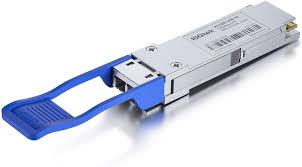
As the demand for high-speed data transmission continues to rise in enterprise and data center networks, the need for reliable, long-range optical connectivity has never been more pressing. Among the various 40 Gigabit Ethernet (40GbE) optical solutions available, 40GBASE-LR4 stands out for its ability to transmit data over long distances using single-mode fiber (SMF). This makes it an essential component in network infrastructures that require both high capacity and extended reach. In this article, we’ll explore what 40GBASE-LR4 modules are, how they work, and why they are a smart choice for long-distance 40G Ethernet connections.
What Is 40GBASE-LR4?
40GBASE-LR4 is a 40 Gigabit Ethernet standard defined by the IEEE 802.3ba specification. The “LR” in LR4 stands for “Long Reach,” and this module is designed to support data transmission over distances of up to 10 kilometers using SMF. The “4” indicates that it uses four separate lanes for transmitting and receiving data. Each lane operates at 10 Gbps, and together they aggregate to deliver a total data rate of 40 Gbps. What makes 40GBASE-LR4 unique is its use of coarse wavelength division multiplexing (CWDM), which allows multiple signals to be transmitted simultaneously over a single fiber by using different wavelengths of light. This approach enables high bandwidth transmission while minimizing the number of fibers required, making it both efficient and cost-effective for long-haul communication.
Technical Overview and Advantages
Technically, 40GBASE-LR4 modules are typically built in a QSFP+ (Quad Small Form-Factor Pluggable Plus) form factor, which is compact and hot-pluggable, allowing easy integration into switches and routers. These modules convert four 10G electrical input channels into four CWDM optical signals, which are then multiplexed to transmit over a single strand of SMF. At the receiving end, the process is reversed, with the module demultiplexing the signal and converting it back into four electrical channels. The wavelengths used in LR4 modules typically range from 1264.5 nm to 1337.5 nm. One of the significant advantages of 40GBASE-LR4 is its ability to maintain high performance over long distances without requiring additional signal boosting equipment. It also offers lower attenuation and better signal integrity compared to multimode solutions like 40GBASE-SR4, especially in environments where longer cable runs are necessary.
Real-World Use Cases
40GBASE-LR4 modules are commonly deployed in large-scale enterprise networks, high-performance computing environments, and data centers that need to link equipment across campus or metropolitan areas. In these scenarios, the ability to transmit data over single-mode fiber up to 10 km is a major advantage. For example, in a campus network, LR4 modules can connect multiple buildings without the need for expensive repeaters or regeneration points. Similarly, cloud providers and telecommunication companies often use LR4 modules to interconnect core routers and aggregation switches across long distances. These modules are also ideal for connecting top-of-rack (ToR) switches to end-of-row (EoR) switches in large-scale data centers, where distances can easily exceed the range of short-reach transceivers.
Deployment and Compatibility Considerations
When deploying 40GBASE-LR4, it’s essential to consider compatibility with existing network infrastructure. Since LR4 uses single-mode fiber and LC connectors, it is often necessary to use MTP to LC breakout cables when connecting to devices that aggregate multiple 10G links. Moreover, network architects must ensure that switches and routers support the QSFP+ form factor and are LR4-compatible. For organizations upgrading from 10G to 40G, 40GBASE-LR4 offers a relatively smooth transition path, especially if their current cabling already supports SMF. However, it is important to weigh factors such as cost and power consumption. While LR4 modules are more expensive and power-hungry than their short-reach counterparts like 40GBASE-SR4, their extended reach and reduced cabling complexity often justify the investment in the right scenarios.
Conclusion
As data demands increase and networks scale to meet performance expectations, 40GBASE-LR4 has emerged as a critical solution for long-range 40 Gigabit Ethernet applications. With its ability to transmit data up to 10 kilometers over single-mode fiber using advanced CWDM technology, LR4 offers a powerful combination of speed, reach, and efficiency. Though it requires careful planning in terms of compatibility and cost, its benefits in long-distance connectivity make it a worthwhile investment for many enterprise and data center environments. Whether you’re building out a campus network or upgrading your backbone infrastructure, 40GBASE-LR4 provides the reliability and performance needed to support today’s bandwidth-intensive workloads.






